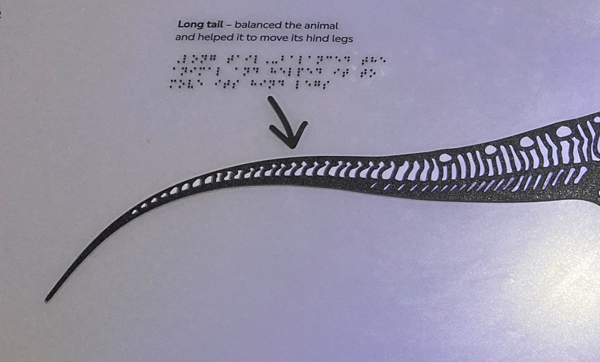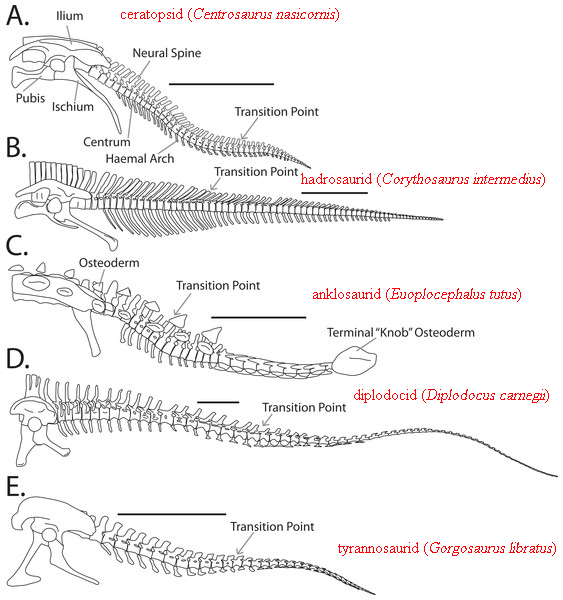How Long is a Dinosaur’s Tail?
How long is the tail of a dinosaur? That’s a good question, one that has quite a complicated answer, but if a definitive assessment of the morphology of caudal vertebrae (tail bones) of the Dinosauria could be carried out, then palaeontologists would be better able to piece together (literally), the tails of dinosaurs and assess their length from even fragmentary remains.
The Tail of a Huge Titanosaur (Sauropod Dinosaur)
Picture credit: Everything Dinosaur
For dinosaur and prehistoric animal models: Prehistoric Animal and Dinosaur Models.
A Dinosaur Tail
Research led by Dr David Hone (Queen Mary University of London), in collaboration with colleague Dr Steven Le Comber (who sadly passed away in 2019) and Dr Scott Persons of Mace Brown Museum of Natural History (Charleston, South Carolina, USA), permitted a comprehensive dataset of dinosaur tails to be built up. The data indicates that there is considerable variation in the caudal vertebrae of members of the Dinosauria. The number of tail bones varies, as does their morphology (shape). In addition, overall length of the tail as a proportion of body size is inconsistent within the very diverse dinosaur clade.
With such variation, comparing tails of different genera or even dinosaurs from the same family will prove troublesome.
However, the scientists did identify some general patterns that could prove useful when it comes to learning about a genus with only a few tail bones to work with.
What’s in a Tail? The Great Variation within the Tails of Dinosaurs
Picture credit: Hone et al (PeerJ) with additional annotation by Everything Dinosaur
General Principles of Dinosaur Tails
Patterns of changes in centra lengths (the central part of each vertebra) along the tails of dinosaurs do vary. However, the researchers did identify some general principles in terms of the bones that make up the tails. For example, when viewing the tail bones from the base of the tail down to the tip, several different dinosaurs show a pattern of short centra, followed by a sequence of longer centra, with the remainder of the tail being made up of a long series of centra tapering in length.
The team suggest that this general pattern is consistent with the function of different parts of the tail, the longer centra quite near to the base of the tail help to provide support for the attachment of the large muscles associated with the top of the leg and this region of the tail. This general pattern is not found in many early types of dinosaur, so the researchers conclude that this trait must have evolved independently in different kinds of dinosaurs over time.
A Reconstruction of the Tail of a Massospondylus
Picture credit: Everything Dinosaur
Deducing Form and Function
Writing in the on-line journal “PeerJ”, the scientists state that the number of vertebrae in a given section of tail can indicate its flexibility or its stiffness. The more vertebrae recorded over a given distance then it is likely that this section of tail was quite flexible. Conversely, the fewer joints in any length of tail will imply reduced flexibility.
General conclusions about dinosaur tails could be made, for example:
- The base of many dinosaur tails was flexible and allowed virtually the whole tail to be swung as a collective whole, helping to stabilise the animal as it moved and perhaps also having a defensive function in some herbivores.
- Just passed the tail base there was a zone of relative stiffness that supported the muscles associated with the tail and rear legs (caudofemoralis musculature).
- After the termination of the caudofemoralis and for a highly variable distance, the remaining vertebrae tapered to a reduced size.
The scientific paper: “New data on tail lengths and variation along the caudal series in the non-avialan dinosaurs” by David W. E. Hone, W. Scott Persons and Steven C. Le Comber published in PeerJ.
Vist the Everything Dinosaur website: Everything Dinosaur.









Leave A Comment